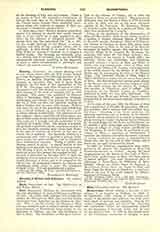

Blois (BLESENSIS), Diocese of, coextensive with the civil department of Loir-et-Cher and a suffragan of Paris. On July 1, 1697, Innocent XII canonically erected the Bishopric of Blois, that territory having theretofore been dependent on the Diocese of Chartres. Prior to the Revolution, the Diocese of Blois was less extensive than at present, almost the entire arrondissement of Romorantin being subject to the Bishopric of Orleans, and the Bas-Vendomois to that of Mans. The Concordat of 1802 gave Loir-et-Cher to the Diocese of Orleans, and in 1822 the Diocese of Blois was reestablished. Monseigneur de Themines, who was Bishop of Blois in 1776 and died in exile in 1829, was one of the most obstinate enemies of the Concordat. St. Solennius, Bishop of Chartres under Clovis, is a patron of Blois; his relics were preserved by a miracle.
Owing to the proximity of the monasteries of Micy and Marmoutier, Blois counts among its saints a number of monks; Lubinus, Bishop of Chartres in the sixth century; Laumerus, Abbot of Corbion in the Diocese of Chartres (d. about 590), whose body was transported to Blois, at the time of the Norman invasions, by fugitive monks, who founded in that city the Abbey of St. Laumer; St. Deodatus, the anchorite, also called St. Die (sixth century), who assured Clovis of the victory at Vouille (507); the solitaries Victor and Leonardus; and Aigulphus (seventh century), a native of Blois and Abbot of Lerins, who was assassinated. Peter of Blois, who came from the Abbey of St. Laumer, was conspicuous in the twelfth century for his defense of St. Thomas Becket and for encouraging devotion to the Blessed Virgin. The Venerable Charles of Blois, killed in 1364 at the Battle of Auray, was the son of Guy, Count of Blois. The Benedictines had several great abbeys in this diocese, one at Selles-sur-Cher, begun as early as the sixth century by the hermit, St. Eusinus, and another at Pontlevoy, now a college. The monastery of the Blessed Trinity at Vendome, dedicated in 1040, was also quite celebrated. The Oratorians Jean Morin and Jerome Viguier, learned ecclesiastics of the seventeenth century, were natives of Blois.
At the close of the year 1905, the Diocese of Blois had a population of 275,538; 28 pastorates, 266 mission churches, and 8 curacies with subventions from the State. According to the latest statistics, the following institutions are to be found in the diocese: 48 infant schools conducted by sisters; 2 orphanages where farming is taught, conducted by the Freres de St. Francois Regis and the Securs du Protectorat de St. Joseph; 7 girls’ orphanages conducted by sisters; 1 house of refuge for young women, conducted by the Religieuses de Notre Dame de la Charite; 5 patronages at Blois; 1 patronage at Romorantin; 8 hospitals and hospices conducted by sisters; 5 houses of retreat conducted by sisters; 5 communities of sisters who care for the sick in their homes; and 9 homes for the aged conducted by sisters.
In 1900 the following congregations were represented in the diocese: the Capuchins at Blois and Premonstratensians at Authon. Among the local congregations are the Sisters of Our Lady of Providence, with mother-house at Blois, who have charge of orphan asylums. The most frequented place of pilgrimage is Notre Dame de Villethion at Saint Amand. Others are Notre Dame de Nanteuil at Montrichard, Notre Dame des Aydes at Blois, and Notre Dame des Blanches at Pontlevoy, a sanctuary built at the end of the tenth century by Gilduin, opponent of Foulques Nerra.
GEORGES GOYAU

